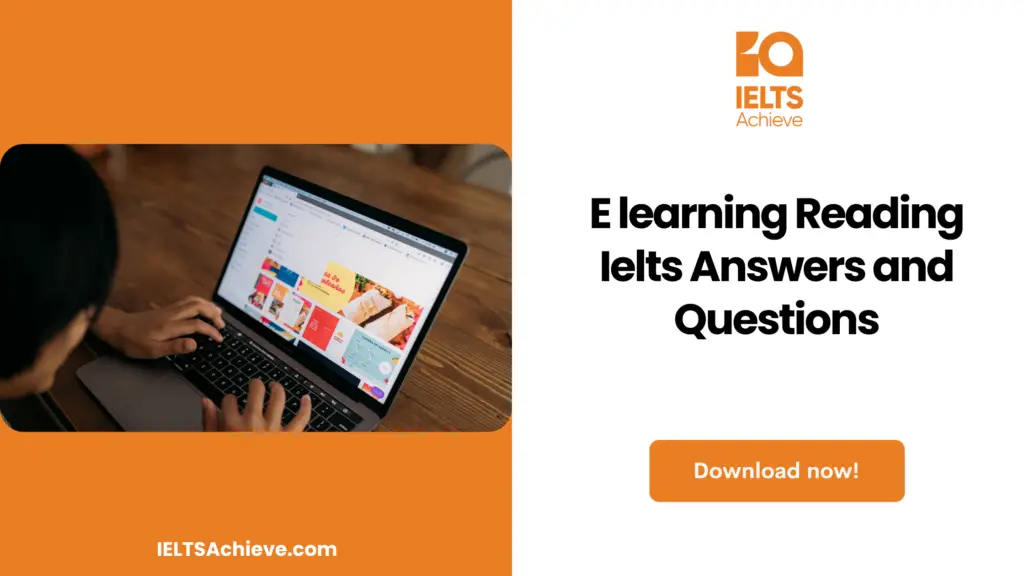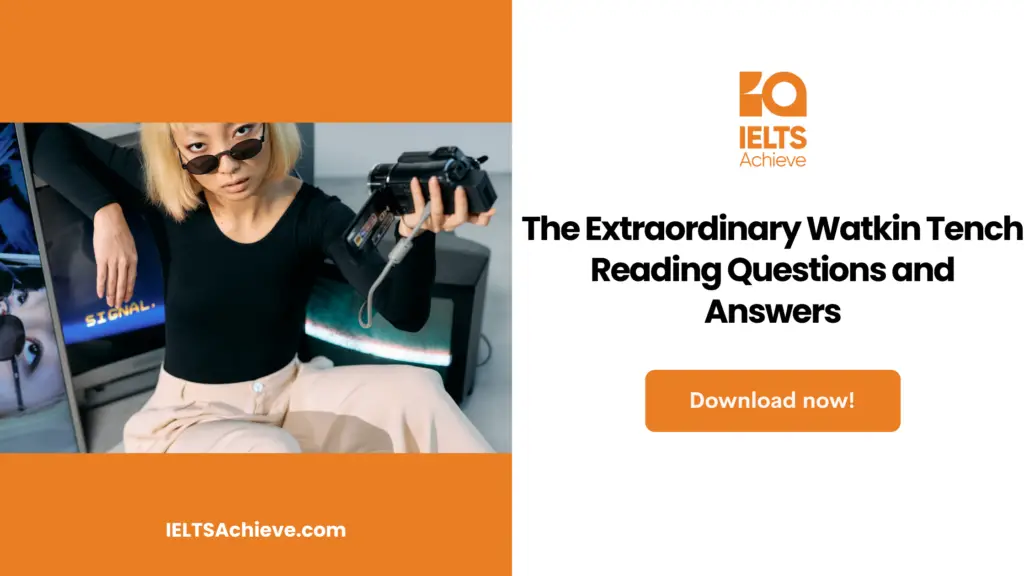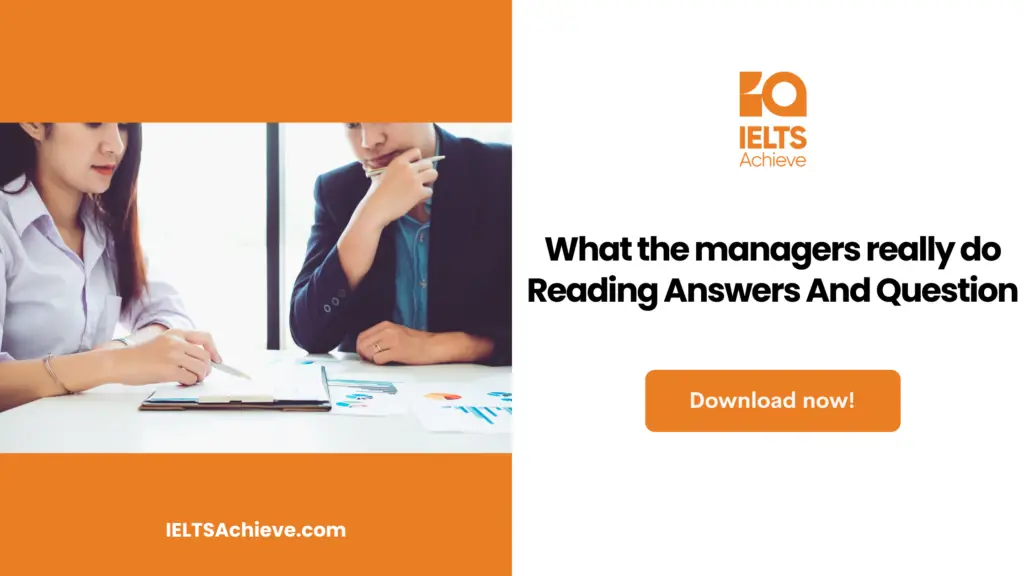The Blog post contains the following IELTS Reading Questions:
- IELTS Reading Matching Headings
- IELTS Reading Summary Completion
- IELTS Reading Yes/No/Not Given
Stay informed and prepared for success – Explore our comprehensive Reading Test Info page to get valuable insights, exam format details, and expert tips for mastering the IELTS Reading section.
IELTS Reading Passage – E learning

E training
Corporate e-learning can greatly benefit from the fact that e-learning is the word that unites the domains of online learning, web-based training, and technology-delivered instruction. For instance, IBM claims that the implementation of their online manager training program, Basic Blue, saved the corporation somewhere between $200 million and $300 million in 1999. The majority of the savings come from eliminating the need for employees and instructors to travel to a single classroom. Employees can learn from any Internet-connected PC, wherever in the world, with an online course. Ernst and Young increased consistency and scalability while cutting training expenditures by 35%.
E-learning has become a top priority for many organizations due to its many advantages, including convenience, uniform delivery, self-paced learning, and a range of available information, in addition to its generally advantageous economic effects. Many people assume that e-learning provides flexible, “any time, any place” learning. The assertion that “any place” is true is a fantastic development and is valid in theory. Rich learning resources are now accessible to many more people than they were in the paper or broadcast distance learning era. E-training has enormous potential for teaching certain knowledge and abilities. It can be particularly useful for assisting staff members in their preparation for IT certification courses. Additionally, it appears that e-learning can effectively address issues like management training, safety training, and sexual harassment education5, all of which have a defined set of objectives. Finally, training professionals advise using a “blended” strategy that alternates between online and in-person training as needed. E-learning is not a magic bullet. However, it has benefits if they help reduce costs and windowless classrooms full of snoring kids.
The technology has received a lot of attention in the debate on how to deploy e-learning, but as Driscoll and others have pointed out, there are many other human variables to consider as well. Any competent manager is aware of the importance of training staff members to ensure a successful firm. Despite this, traditional classroom training carries the danger of being pricy, cumbersome, and frequently unsuccessful. The fact that the classroom requires individuals to leave their employment is possibly its biggest drawback. Each minute an employee spends in a classroom learning is a minute they are not working on the shop floor. Now, it appears as though there is a technique to get over these limitations of conventional training. With the goal of allowing each student to learn at their own pace, e-training offers more effective teaching methods by incorporating audio, video, animation, text, and interactive materials. Along with improved performance outcomes, students also immediately benefit from increased task retention, higher motivation, and a reduction in test anxiety for many students. According to a California State University Northridge research, e-learners outperformed traditional learners by 20%. Nelson found a substantial difference in performance between 406 university students who took traditional and online education courses, with the latter group outperforming the former.
However, no one ever claimed that E-training technology would be affordable. On average, e-training service providers charge between $10,000 and $60,000 to create one hour of online education. The cost varies according to the difficulty of the training subject and the media employed. As opposed to flash animations or streaming video, HTML sites are a little less expensive to create. Cost is only the beginning when it comes to course content. The technological foundation is also a part of a whole e-learning solution (the computers, applications and network connections that are used to deliver the courses). A learning management system (LMS) is a type of technology platform that can be installed on-site or outsourced. You’re left with a hefty fee after factoring in the costs of the network bandwidth investments required to provide multimedia courses. The first year’s costs for the LMS infrastructure and a dozen or more online courses can reach $500,000 or more. Custom e-training is now only a possibility for large enterprises due to these kinds of expenditures. The e-training idea pays for itself for businesses with a big enough workforce. Large corporations are making significant investments in online training in light of this fact. More than half of Rockwell Collins’ 400+ courses are now given directly to customers in an e-learning format, cutting company yearly training expenditures by 40%. There are plenty such success tales.
The classroom isn’t anticipated to be completely replaced by e-learning. One of the problems with delivering multimedia over the Internet is still bandwidth restrictions. E-training isn’t appropriate for every form of instruction or subject, as well. For instance, establishing teams or transferring cultural values is relatively ineffective. It would be challenging to explain your company’s distinctive corporate culture to new hires over a computer monitor. For these goals, group training sessions are more suitable. Because of the time spent creating and instructing online courses, there is also a perceived loss of research time. Between 500 and 1,000 person-hours, or Wallin-hours, according to Professor Wallin, were needed to maintain the course’s relevance and usefulness. (Despite the sophistication of the courseware system, distance learning instructors frequently need technical expertise.) That is equivalent to one-fourth to one-half of a person-year. A final requirement for teaching materials is equipment and computer literacy. Any e-Learning system requires some fundamental tools and a working knowledge of computers in order to complete the activities specified by the system. A learner cannot complete an e-Learning program successfully if they lack these abilities or access to these resources.
While there is little debate about the obvious benefits of e-learning, thorough research is required to demonstrate that students are actually learning and applying the skills they are being taught online and that e-learning is the most effective method for achieving the desired results in a corporate setting. A go-between form of blended learning, which describes the blending of several learning contexts, is becoming more and more common nowadays. It mixes conventional in-person teaching techniques with more contemporary computer-mediated activities. The technique creates a more integrated approach for teachers and learners, according to the strategy’s proponents. In the past, technology-based learning tools supported in-person training. Technology will take on a bigger role through a mixed learning approach.
Unlock your full potential in the IELTS Reading section – Visit our IELTS Reading Practice Question Answer page now!
Recommended Questions:
Renewable Energy IELTS Reading Question with Answer
E learning IELTS Reading Questions
Question 1-6
The reading passage has seven paragraphs A-F Choose the correct heading for paragraphs A-F from the list below. Write the correct number, i-xi in boxes 1-6 on your answer sheet.
- Paragraph A
- Paragraph B
- Paragraph C
- Paragraph D
- Paragraph E
- Paragraph F
Ready to conquer Matching Headings questions? Click here to learn essential tips and techniques for matching headings accurately to paragraphs or sections in the IELTS Reading section.
Question 7-10
The reading passage has seven paragraphs A-F. Which paragraph contains the following information? Write the correct letter A-F, in boxes 7-9 on your answer sheet.
7. IBM’s Basic Blue project was a huge success.
8. Due to its flexibility, e-learning is a top goal for many organizations.
9. The best learning environment may be a hybrid of traditional and online learning.
10. An illustration of a quick electronic delivery of a company’s goods to customers.
Question 11-13
Choose Three correct letters, among A-E Write your answers in boxes 11-13 on your answer sheet.
A technical infrastructure is hard to come by.
B Due to bandwidth restrictions, online multimedia presentation is limited.
C It is ineffective to instill a distinctive corporate value in new hires.
D Employees must schedule a significant amount of time to be away from their jobs for training.
E To keep the course at the appropriate level, more preparation time is required.
11. ……. 12. ……. 13. …….
Unlock your full potential in the IELTS Reading section – Visit our IELTS Reading Practice Question Answer page now!
Recommended Questions:
Renewable Energy IELTS Reading Question with Answer
E learning Reading Answers
1. i
2. ix
3. iv
4. vii
5. v
6. iii
7. A
8. B
9. F
10. D
11. B
12. C
13. E

We hope you found this post useful in helping you to study for the IELTS Test. If you have any questions please let us know in the comments below or on the Facebook page.
The best way to keep up to date with posts like this is to like us on Facebook, then follow us on Instagram and Pinterest. If you need help preparing for the IELTS Test, join the IELTS Achieve Academy and see how we can assist you to achieve your desired band score. We offer an essay correction service, mock exams and online courses.


